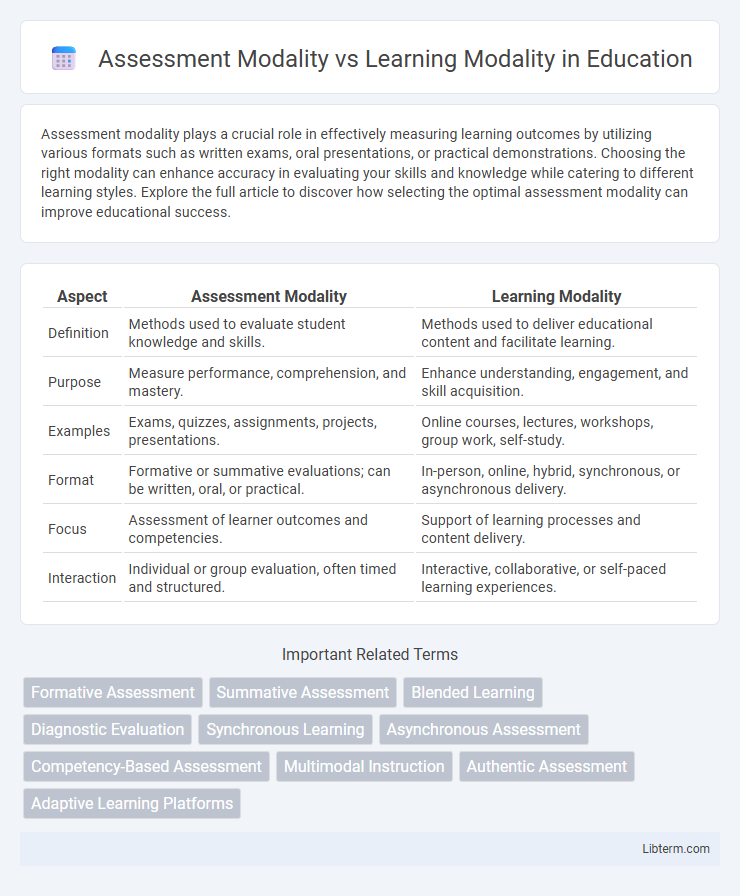Assessment modality plays a crucial role in effectively measuring learning outcomes by utilizing various formats such as written exams, oral presentations, or practical demonstrations. Choosing the right modality can enhance accuracy in evaluating your skills and knowledge while catering to different learning styles. Explore the full article to discover how selecting the optimal assessment modality can improve educational success.
Table of Comparison
| Aspect | Assessment Modality | Learning Modality |
|---|---|---|
| Definition | Methods used to evaluate student knowledge and skills. | Methods used to deliver educational content and facilitate learning. |
| Purpose | Measure performance, comprehension, and mastery. | Enhance understanding, engagement, and skill acquisition. |
| Examples | Exams, quizzes, assignments, projects, presentations. | Online courses, lectures, workshops, group work, self-study. |
| Format | Formative or summative evaluations; can be written, oral, or practical. | In-person, online, hybrid, synchronous, or asynchronous delivery. |
| Focus | Assessment of learner outcomes and competencies. | Support of learning processes and content delivery. |
| Interaction | Individual or group evaluation, often timed and structured. | Interactive, collaborative, or self-paced learning experiences. |
Understanding Assessment Modality
Assessment modality refers to the specific method or medium through which student knowledge and skills are evaluated, such as written tests, oral presentations, or practical demonstrations. It plays a crucial role in accurately measuring learning outcomes by aligning assessment formats with the intended cognitive skills and learning objectives. Understanding assessment modality enables educators to select appropriate evaluation techniques that reflect student competencies and support diverse learning styles.
Defining Learning Modality
Learning modality refers to the preferred sensory channel through which an individual absorbs, processes, and retains information, commonly categorized into visual, auditory, kinesthetic, and reading/writing modalities. This concept shapes instructional strategies by aligning teaching methods with learners' dominant modalities to enhance comprehension and retention. Understanding learning modality supports personalized education, facilitating more effective knowledge transfer and skill acquisition.
Key Differences Between Assessment and Learning Modalities
Assessment modality refers to the methods and tools used to evaluate student performance, such as written exams, oral presentations, or practical demonstrations, while learning modality pertains to the preferred ways individuals acquire knowledge, including visual, auditory, kinesthetic, or reading/writing styles. Key differences lie in their purpose and application; assessment modalities measure comprehension and skills, providing feedback on learning outcomes, whereas learning modalities influence instructional design to optimize information absorption. Understanding these distinctions enables educators to tailor teaching strategies and assessments to better align with diverse learner needs and improve educational effectiveness.
Types of Assessment Modalities
Assessment modalities include formative, summative, diagnostic, and performance-based assessments, each tailored to measure different aspects of student learning and understanding. Formative assessments provide ongoing feedback during the learning process, while summative assessments evaluate cumulative knowledge at the end of an instructional period. Diagnostic assessments identify learners' strengths and weaknesses prior to instruction, and performance-based assessments require students to demonstrate skills through practical tasks or projects.
Types of Learning Modalities
Learning modalities encompass visual, auditory, kinesthetic, and reading/writing styles, each catering to different learner preferences and cognitive strengths. Assessment modalities refer to the methods used to evaluate knowledge and skills, such as written tests, oral presentations, practical demonstrations, and multimedia projects. Matching assessment modalities with learning modalities enhances educational effectiveness by aligning evaluation techniques with how individuals best absorb and process information.
Impact of Assessment Modality on Student Performance
Assessment modality, such as online quizzes, in-person exams, or project-based evaluations, significantly influences student performance by aligning evaluation methods with individual learning preferences. Research indicates that students assessed through formats matching their preferred learning modality--visual, auditory, or kinesthetic--demonstrate higher retention and engagement levels. Misalignment between assessment modality and learning style can lead to increased anxiety and lower achievement, underscoring the importance of diversified assessment strategies in educational settings.
Relationship Between Assessment and Learning Modalities
Assessment modality and learning modality are intrinsically linked, as the effectiveness of assessment largely depends on alignment with the learner's preferred modality, such as visual, auditory, or kinesthetic. Research indicates that when assessment methods mirror the learning modality, retention and comprehension improve, enhancing overall educational outcomes. Mismatched modalities between assessment and learning can lead to inaccurate measurements of true understanding and skill acquisition.
Best Practices for Aligning Modalities
Effective alignment between assessment modality and learning modality enhances educational outcomes by ensuring consistency in instructional methods and evaluation techniques. Best practices emphasize selecting assessment types that mirror the learning activities, such as using project-based assessments for experiential learning or multiple-choice tests for fact-based instruction. Incorporating technology-enabled tools that support synchronous and asynchronous interactions can further optimize alignment and accommodate diverse learning preferences.
Challenges in Integrating Multiple Modalities
Integrating multiple assessment and learning modalities presents challenges such as aligning diverse formats to consistent evaluation standards and addressing varied student preferences and accessibility needs. Ensuring valid and reliable outcomes requires sophisticated design to accommodate differences in digital, visual, auditory, and kinesthetic learning and assessment types. Balancing technological infrastructure and instructor training further complicates seamless implementation across modalities.
Future Trends in Modalities for Education
Emerging future trends in educational modalities emphasize adaptive assessment technologies integrated with personalized learning platforms, enabling real-time evaluation aligned with diverse learning styles such as hybrid, synchronous, and asynchronous modalities. Predictive analytics and AI-driven assessments will transform traditional summative assessments into continuous, formative feedback systems, tailoring content delivery to individual learner progress and preferences. Virtual and augmented reality environments will further bridge assessment and learning modalities, creating immersive experiences that holistically measure cognitive and practical skills in dynamic educational contexts.
Assessment Modality Infographic

 libterm.com
libterm.com